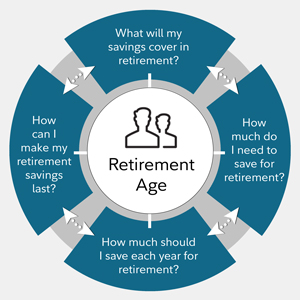Get answers to 4 key retirement questions
How much should I save each year for retirement?Aim to save at least 15% of your income annually—start as soon as you can.
How much do I need to save for retirement?Fidelity's guideline: Save 10x your income by age 67.
What will my savings cover in retirement?Plan for your savings to provide 45% of your pretax, preretirement income.
How can I make my retirement savings last?Withdraw no more than 4% to 5% from savings yearly, with adjustments for inflation.
See how it all works together
Find out how our 4 guidelines work together to help you on your retirement journey.
Reaching your retirement savings goals starts with developing a roadmap now. That’s why we did the analysis and developed guidelines based on 4 key metrics: a yearly savings rate, a savings factor to help you see where you stand, an income replacement rate, and a potentially sustainable withdrawal rate.
All 4 metrics are interconnected. It’s important to understand how they work together and keep each in mind as you save for retirement. Each metric is described in separate articles. There are also tools to illustrate how you can customize the assumptions based on your situation.
4 rules for retirement savings

Use our tools to help you plan
Retirement saving
Estimate how much to save each year for retirement.
See how you're doing
Get your Fidelity Retirement ScoreSM—it's like a credit score for retirement.

